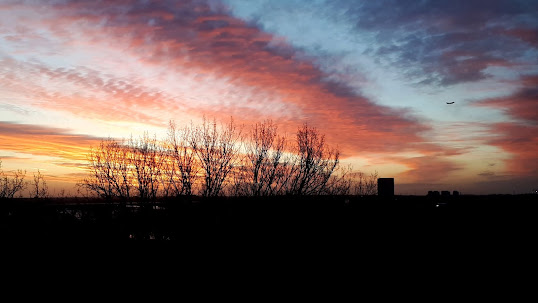Thursday, 16 September 2021
Misa Criolla
Thursday, 12 August 2021
A cathedral for birdsong
A cathedral for birdsong
If you walk through my park (yes, the Rhapsody in the Park that inspired the previous watercolour), you may chance upon a quiet pathway leading into an enclave of very tall trees. As you stand in their dappled shadows, it feels cool and quiet like a sanctuary, a cathedral, but as you look up, suddenly a delightful cacophony of birdsong bursts out above you, an invisible animated discussion on this intruder into their dwelling. Their tweets, trills, cheeps and chirrups inspire flashes and jabs of sound-colour here and there in my treetops. This is undoubtedly a magical space.
I'm reminded of the French composer and ornithologist Olivier Messiaen (1908-1992), who spent hours making tape-recordings of birdsong that might be incorporated into his music. He would be thrilled to stand here with his tape-recorder and no doubt argue with me about the colours we hear. How would he hear my carpet of blue/violet intermingled with dappled reds? His Catalogue d' Oiseaux for piano is, like bird song, full of abstract angular and unmelodic sounds. Messiaen had, like me and many others, synaesthesia - an intuitive reaction to music in terms of colour (or vice versa). Here's one shot from my kinetic paintings performed in 2012 with pianist Pierre-Laurent Aimard to Cloches d’adieu – et un sourire. In memoriam Olivier Messiaen by composer Tristan Murail. Both musicians studied with Messiaen. My continuous images were painted live on projectors in response to the overlapping bell-like sounds from the piano.
Wednesday, 16 June 2021
Rhapsody in the Park
Monday, 31 May 2021
A young artist waiting for the music
I can't help reminiscing on the extraordinary nature of my artistic life, a roller-coaster of excitement, hopes and also some disillusionments. Although rather proud of many projects, there is still a sadness about the creative ideas that failed to find form and production. Sometimes this was just bad luck, bad timing or my network of colleagues and agents moving on, factors that had nothing to do with the quality of the proposals. Then, in the mid-seventies, the world became flooded with an obsession for all things digital, so organically foreign to the joys and sensual beauty of my analogue brushstrokes. Here's the Link to a blog from 2017: Analogue is alive and well.
Sunday, 17 January 2021
The Big Move
The Big Move
After thirty-five years living virtually in a treetop in Amsterdam South, I've now moved to an apartment that has a wonderful view from the ninth floor over the treetops of the East-side park. It's been a emotional experience, having to say goodbye to a gracious house, built in 1914 near the Concertgebouw, with so many happy and sad memories, where my children grew up and where their mother died. She played in the Concertgebouw, where I also painted live kinetic images to many concerts, so it became our second home.
The move meant down-sizing, saying farewell to my favourite tree outside the window, to innumerable archives and documents, contracts and proposals for exhibitions and performances worldwide, all written or faxed on paper, many of which were successful and some that sadly never came to fruition. At eighty-seven, I look back nostalgically on a very long career, about which you can read in my blogs at www.normanperryman@blogspot.com.
All went well! I'm now living in an Amsterdam apartment block for retired senior citizens, in a quarter where the streets are named after the colonial Dutch East Indies. My address is Kramatplantsoen, Kramat being a small town in Java with a chequered history, but also the term for the burial-ground of a highly-placed person. Duly noted. I've discovered that it only takes me three minutes to climb the nine flights of stairs.Artists don't know the meaning of retirement of course. We have an inner need to create, for as long as we can hold a paintbrush. My studio and commissions await, but after this exhausting process, I first need a little break. Here's the fanfare of colours to which I awoke on my first day. Yes, it was a good move.
















